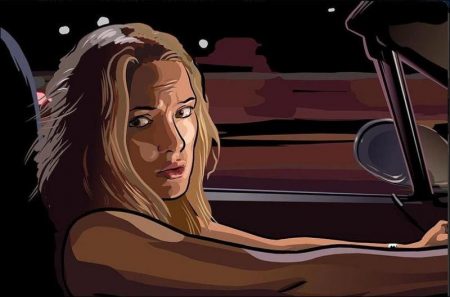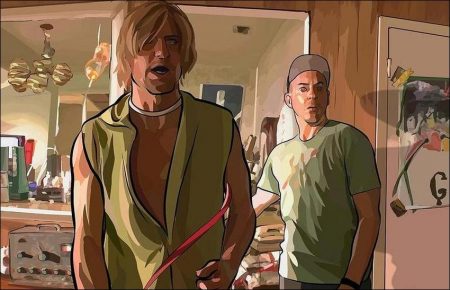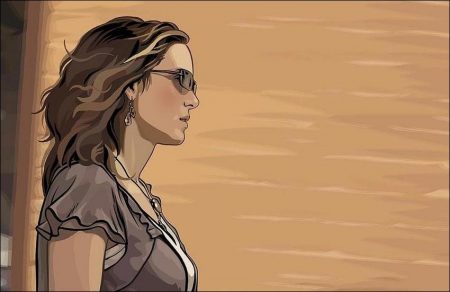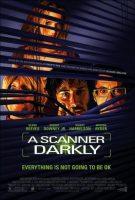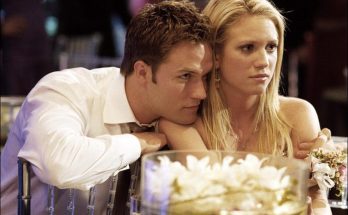Tagline: Taglines: What Does A Scanner See?
Location: Suburban Orange County, California.
Time: The near future.
“A Scanner Darkly” is set in suburban Orange County, California in a future where America has lost the war on drugs. When one reluctant undercover cop is ordered to start spying on his friends, he is launched on a paranoid journey into the absurd, where identities and loyalties are impossible to decode. It is a tale of drug use based on the novel by Philip K. Dick and his own experiences.
Like a graphic novel come to life, “A Scanner Darkly” will use live action photography overlaid with an advanced animation process (interpolated rotoscoping) to create a haunting, highly stylized vision of the future. The technology, first employed in Richard Linklater’s 2001 film “Waking Life,” has evolved to produce even more emotional impact and detail.
America’s endless and futile war on drugs has become one and the same with its war on terror. Reluctant undercover cop Bob Arctor (Keanu Reeves) follows orders to start spying on his friends, Jim Barris (Robert Downey Jr.), Ernie Luckman (Woody Harrelson), Donna Hawthorne (Winona Ryder) and Charles Freck (Rory Cochrane). When he is directed to step up the surveillance on himself, he is launched on a paranoid journey into the absurd, where identities and loyalties are impossible to decode.
Based on legendary science-fiction author Philip K. Dick’s own experiences, “A Scanner Darkly” tells the darkly comedic, caustic, but deeply tragic tale of drug use in the modern world. The film plays like a graphic novel come to life with live-action photography overlaid with an advanced animation process—a method known as interpolated rotoscoping, first employed in writer/director Richard Linklater’s 2001 film “Waking Life” — to create a haunting version of America, seven years from now.
About the Production
Philip K. Dick has slowly but steadily become a cultural icon with his works of mind-bending fiction. His first novel debuted in 1955, and ever since, his cumulative works have sold roughly 20 million copies and been translated to 25 different languages.
Considered by some measures to be the most adapted science-fiction author in the history of film, Dick has created futuristic worlds in many of his works, several of which have been adapted into feature films: “Blade Runner,” based on the novel Do Androids Dream of Electric Sheep?; “Total Recall,” based on the short story “We Can Remember It For You Wholesale;” “Screamers,” based on the short story “Second Variety;” the French film “Confessions d’un Barjo,” based on “Confessions of a Crap Artist;” and “Minority Report,” “Impostor” and “Paycheck,” based on works of the same name. The movies have brought new fans to Dick’s work.
Never out of print in its 27-year existence, A Scanner Darkly is one of the three top-selling Dick novels and only the second novel of Dick’s to be adapted. The story of how A Scanner Darkly became a film begins with a respect for Philip K. Dick shared by writer/director Linklater and producer Tommy Pallotta—a mutual admiration often talked about on the set of “Waking Life.”
In crafting the adaptation, Linklater wanted to convey as much of the comical perspective as possible. “To remain true to the book is to attempt something that is more difficult in film than in literature, which is to be both a comedy and a tragedy at the same time. I wanted the film to capture the humor and exuberance of the book but not let go of the sad and tragic. It’s a tonal challenge for sure, but that is the heart of the story.”
“Because his stories and novels often involve futuristic elements, they are a popular source for movies. People have taken core ideas from his stories, and have turned them into big actionthrillers. A Scanner Darkly is a different kind of story though. It’s not plot-driven in that way. It’s really about these guys and what they’re all doing in their alternate world and what’s going through their minds is really what keeps the story moving. So though it’s officially in the genre of science fiction, it’s much more character-based than plot driven. In that way, it’s different than many portrayals of the future. In this, you have people who are living their lives, hanging out, just trying to get through their day,” explains Linklater. Pallotta adds, “We felt the material called for a really faithful adaptation of Dick’s uniquely, humorous perspective of a very dark and disturbing issue.”
Linklater’s first foray into animation had been “Waking Life,” a film Wired magazine called “the first independent computer-animated feature film ever made in America—an abstract, psychedelic, digital video improv that takes the Disney / Pixar formula and turns it on its perfectly coiffed head.” He thought A Scanner Darkly lent itself to trying animation again.
To stay true to their goal, Linklater and Pallotta enlisted the help of two of the stewards of the Philip K. Dick trust, Dick’s daughters Laura Leslie and Isa Hackett. “We were originally approached by Tommy with the enticement of a faithful adaptation,” say Leslie and Hackett. “When we read Richard’s screenplay, and then had the opportunity to meet with him and discuss his and our visions of ‘Scanner,’ we knew this was the right way to go.
Linklater recalls the Bay Area meeting with the author’s daughters. “I think they appreciated the fact that I wanted to stay faithful to the book and tell the whole story,” he explains. “I wasn’t going to be cavalier with the drug aspect. They were very frank—they said, ‘You know, if it wasn’t for drugs, our dad would still be writing today, instead of dying in 1982.’ It’s been a wonderful addition to have Phil K. Dick’s daughters on board with us spiritually.”
Continue Reading and View the Theatrical Trailer
A Scanner Darkly (2006)
Directed by: Richard Linklater
Starring: Keanu Reeves, Winona Ryder, Robert Downey Jr., Woody Harrelson, Rory Cochran, Natasha Janina Valdez, Angela Rawna, Eliza Stevens, Sarah Menchaca, Chamblee Ferguson
Screenplay by: Richard Linklater
Production Design by: Bruce Curtis
Cinematography by: Shane F. Kelly
Film Editing by: Sandra Adair
Costume Design by: Kari Perkins
Set Decoration by: Joaquin A. Morin
Music by: Graham Reynolds
MPAA Rating: R for drug and sexual content, language, a violent image.
Distributed by: Warner Independent
Release Date: July 7, 2006
Visits: 217
